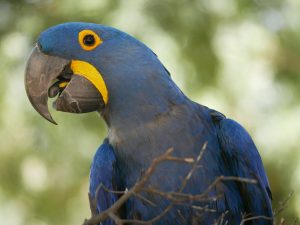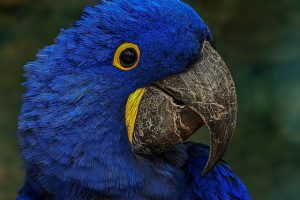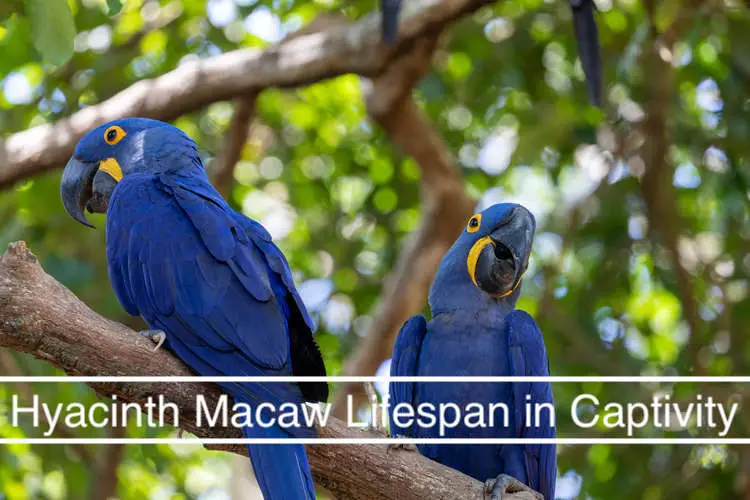The Hyacinth Macaw lifespan in captivity is an important detail/information an individual buying or adopting this stunning/attractive parrot would like to know.
While its physical attributes (gorgeous cobalt-blue appearance and huge size) are enough to attract interested buyers.
Especially pet lovers who have enough resources (money, space, and time) to carter for healthy living.
A lot of people want to know how long these exciting birds can live or stay as a member of their family, ensuring they keep their expectations in check.
This article highlights how long a Hyacinth Macaw could live (average age) and the factors that could affect the lifespan.
Basics Facts of Hyacinth Macaw Lifespan in Captivity

The Hyacinth Macaw can live between sixty (60) to eighty (80) years in captivity, competing with its caregivers when it comes to longevity.
It is no news that they sometimes live longer than their owners.
Although these birds have an extended lifespan, living up to the stipulated number of years is dependent on several factors.
Hyacinth Macaws need the best living conditions to remain healthy in captivity for a very long time.
Compared to other Macaw species, these parrots demand the most attention.
The time required to train, bond, and care for them are more than other Macaw breeds or species.
Before anyone considers bringing this bird home, you need to realize the requirements.
Take as much time to think about the decision thoroughly to ensure you make the right decision.
Hyacinth Macaws are not birds that any interested individuals of bird lovers could just pick up and bring to their homes.
It takes a high level of patience and commitment to training them.
A Hyacinth Macaw would only live for a long time (within the estimated lifespan or life expectancy) if it gets the best treatment and care from the owner or caregiver.
The owner must have the financial capability to attend to special/primary needs (food, housing, and veterinary visits).
If you need a new cage for your Budgies then this guide might be helpful.
Learn About Hyacinth Macaw Lifespan
01. Lifestyle
Macaws are known to live for a long time. However, how long these birds live varies, depending on their lifestyle.
Due to the high level of competition in the wild, the Hyacinth Macaws are prone to attacks from predators.
Also, when they fall sick, there is no access to veterinary attention/care, which could lead to premature death.
In captivity, the Hyacinth Macaws are free from natural predators have access to advanced protection, safety, and health.
These benefits/privileges make them live longer than those in the wild.
02. Size
Large birds are known to live longer than smaller birds. Basically, the larger the bird, the longer the life expectancy or lifespan.
Hyacinth Macaw is the largest when placed side-by-side with other Macaw breeds/species.
As a result, they live longer than all other Macaws and parrot breeds/species, provided the living conditions are excellent/adequate.
03. Reproduction
A Hyacinth Macaw reaches the reproductive age, starting from six (6) years. However, this may extend to ten (10) years in some cases.
These birds are believed to keep reproducing up to about forty (40) years after their reproductive cycle begins.
For instance, a Hyacinth Macaw whose reproductive age begins at six (6) years could continue until forty-six (46).
While in the wild, the male and female hyacinth Macaws handle different responsibilities.
The male birds are tasked with protecting and providing for their family (exposing them to more danger) while the female birds lay eggs.
Provided the bird could resist attack from predators or withstand conditions that frequently shortens their lifespan (which is not always common).
An average life expectancy of seventy (70) years is possible. A Hyacinth Macaw could live for eighty (80) years in captivity or home.
If you want a big cage for your large bird then this guide is here to help.
04. Health
Hyacinths are great eaters. They love fruits, berries, vegetables, nuts, and leafy greens.
While in the wild, they search for their own food, making it difficult to differentiate between toxic/poisonous foods.
Even if these birds are not attacked by predators or lucky to stay safe/free from illegal hunting or poaching. Eating toxic foods could lead to premature death.
For Hyacinth Macaws in captivity, while the owner could pay attention to the diets and ensure the foods are safe enough for consumption.
In most cases, contaminations that could result in diseases or the bird’s death could come from the accessories/toys purchased to bring fun and excitement.
Ensure the toys are safe enough (non-toxic) and ensure the cage is adequately and regularly cleaned.
Whenever there is a drop in the bird’s activity or performance (once you perceive that something is wrong with the way the bird eats or behaves). Talk/speak to an avian veterinarian immediately.
05. How Long Do Different Macaw Breeds Live
Macaws have an impressive lifespan. They can live for a long number of years in captivity, and in the wild, provided the conditions are favorable.
Macaws can live between twenty-five (25) and sixty (60) years. Some species live longer/grow older than others.
Considering all the seventeen (17) Macaw species, the Hyacinth Macaws has the longest or most extended lifespan (average of 60 years).
Hyacinth Macaw Scientific Name
The Hyacinth Macaw is also called or referred to as Blue Parrot. When it comes to the scientific name, this giant bird is referred to as Anodorhynchus hyacinthinus.
Hyacinth Macaw Habitat and Food

a) Habitat
The Hyacinth Macaws originate from eastern and central South America.
These birds are known to make eastern Bolivia, Pantanal wetland (Brazil), Cerrado region (Brazil), northeastern Paraguay, and Amazon basin (Brazil) their home.
Hyacinth Macaws have a great/top preference for the woodlands, palm swaps, and semi-open zones/regions in their natural habitat while choosing their dwelling place.
They are also fascinated by areas that are close to rivers.
The Hyacinth Macaws are hardly found in dense areas or humid forests. They avoid such regions or locations as much as possible.
b) Food
Naturally, Hyacinth Macaws are vegetarians (they do not feed on flesh. They eat/consume plants alone)
While in the wild, Hyacinth Macaws are known to eat vegetables, nuts, fruit, berries, and greens.
Their beak is strong enough to break through or crack any size of coconut open.
While living with humans (in captivity), they can feed on parrot mix or pellet, with the addition/combination of vegetables, fruit, seeds, and nut.
Usually, these birds require a lot of energy to stay active/alive than any other breeds/types/varieties of parrots.
Hence, ensure their food contain a significant amount of carbohydrate. Corn and rice porridge are great options.
Hyacinth Macaw: Where Do They Live in The Wild?
In the previous section, the regions/areas that these birds live/dwell in their natural habitat were highlighted.
Hyacinth Macaws do not like heat. Hence they prefer to build their homes/nests in areas that allow adequate air and is minimally cold.
While in any of the areas they choose to call home, these birds build/construct their nest within tree hollows.
As Hyacinth Macaws grow in size, they keep expanding the tree hollows and nests using their strong beak and paws.
Asides from living inside the tree hollow. Another popular place these birds look at when choosing a place to live or set up their nest is near the river.
Using their powerful paws, they can easily dig/create holes in the hillside, very close to the rivers.
While in the wild, the male Hyacinth Macaws are the primary provider and protector.
They search for food for their family and protect them from predators, especially when the females incubate their eggs during the reproduction cycle.
If you want a cozy cage for your Parakeet then this guide is for you.
Hyacinth Macaw Color & Variations
One of the numerous unique attributes the Hyacinth Macaws possess is their fine-looking/attractive blue (dark/solid) feathers.
The feather’s color complement the yellow (bright) patches across the lower corners/parts of the beak and around the eyes, forming a ring on both eyes.
Hyacinth Macaws have the same color, irrespective of gender (male or female) and size (the young and adult birds).
Although these birds have the same color across all ages/sizes, the young Hyacinth Macaws can be easily differentiated by their shorter tails.
Since both genders can’t be differentiated by color, it takes DNA testing to find out this vital information.
Important Tips For Hyacinth Macaw Care

01. Getting The Ideal Cage/Housing
The Hyacinth Macaw is the largest parrot you will find around. Aside from their big size, they also have strong body parts, especially the beak and paws.
By settling for a random cage (the ones made from average/low-quality materials), durability might be significantly impacted.
They could easily break the cage open or bend its components using their beaks. There are only a few cage designs that can conveniently accommodate these birds.
An interested caregiver/owner may need to consult a construction expert to fabricate the cage using the best materials that cannot be destroyed or damaged with their strong beak.
02. Food
Ensure these birds are fed nourishing diets. Do not limit their meal consumption to parrot mix or pellet. Instead, mix it with some of their special/favorite foods.
The Hyacinth Macaws enjoy food such as corn, leafy greens, fruit, palm nuts, berries, coconuts, rice porridge, and vegetables in the wild.
These classes or categories of foods can be integrated into their diet while in captivity for enhanced health, nourishment, and growth.
03. Time
Hyacinth Macaws are attention lovers. They love private time with their owners/caregivers more than other Macaw species.
Before bringing this bird home or making it a part of the family, ensure you are committed to showering it with much love and attention.
At least 3-4 hours of bonding and moving around the house (in an open space to spread the wings and exercise the body/muscles) is needed every day.
When Hyacinth Macaws are locked up in a cage without adequate freedom, they could become hostile and destructive.
04. Health
Inspect their toys appropriately/carefully during purchase to ensure they are not contaminated (free from toxins).
A contaminated toy could lead to diseases, affecting the bird’s health or even leading to their death if care isn’t taken. Also, make sure their house/cage is clean at all times.
Whenever the bird falls sick or becomes inactive, visit the vet immediately.
Some Fun Facts About Hyacinth Macaw
- Hyacinth Macaws are the biggest/largest parrots. They have a huge/strong beak, which is capable of splitting coconut’s shell
- The cost of acquiring the Hyacinth Macaw from a breeder is higher than any other parrot species/breeds
- These birds are beautiful, attractive, and intelligent
- Hyacinth Macaws are known to live and move around in groups. The group makes up about ten (10) birds in total
- Considering these birds’ high level of intelligence, they can quickly learn/understand about thirty (30) words.
- They can live for up to 60 years on average, extending to about 80 years under the best care/conditions
- An adult Hyacinth Macaw is about forty (40) inches in size, ranging from the head to the tail
- The wing of an adult Hyacinth Macaw is about four (4) feet when fully extended
- On average, an adult Hyacinth Macaw weighs about 2.6 pounds. Nevertheless, they can grow up to 3.7 pounds
- On average, Hyacinth Macaws become old/mature enough to reproduce at eight (8) years. That is between six (6) and ten (10) years
- The reproductive stage could last for about forty (40) years. This means that Hyacinth Macaw can continue reproducing (mating and laying eggs) even when they are 50 years of age
- Hyacinth Macaws do not start mating until the beginning of summer
- The females are known to lay between two (2) and three (3) eggs, with incubation lasting up to about a month (thirty days)
- During incubation, the male Hyacinth Macaw gets the food the female needs to survive and as well watch over the next, providing adequate protection against intruders or predators
- Young Hyacinth Macaws do not fly or leave the nest until twelve weeks (three months).
People Also Ask For
Are hyacinth macaws friendly?
Hyacinth macaws are generally considered friendly and affectionate birds when properly socialized and raised in a nurturing environment. They can form strong bonds with their human caretakers and engage in interactive behaviors. However, individual personalities can vary, and some hyacinth macaws might be more reserved or cautious in their interactions.
Are hyacinth macaws noisy?
Yes, hyacinth macaws can be quite noisy. They have powerful voices and can produce loud squawks, calls, and screeches. While their vocalizations are a natural way for them to communicate with each other in the wild, potential owners should be prepared for their vocal tendencies and provide appropriate training and enrichment to manage their noise levels.
Do Hyacinth macaws bite?
Yes, like many parrot species, Hyacinth macaws have the potential to bite. Biting can occur due to various reasons, including fear, stress, territorial behavior, or discomfort. Proper training, socialization, and understanding their body language can help minimize the likelihood of biting and foster a positive interaction between these magnificent birds and their human companions.
How fast can a hyacinth macaw fly?
The majestic hyacinth macaw can reach speeds of around 35 to 40 miles per hour (56 to 64 kilometers per hour) when flying.
How do Hyacinth macaws sleep?
Hyacinth macaws sleep by perching on branches, often tucking one leg into their feathers to conserve warmth. They usually rest in quieter, secure spots within their habitat, adopting a quiet and restful posture during their nighttime sleep.
What is the diet of a hyacinth macaw?
The diet of a hyacinth macaw primarily consists of a variety of nuts, seeds, fruits, and vegetation. They have a particular preference for palm nuts such as acuri and bocaiuva, which provide them with essential nutrients for their vibrant plumage and overall health.
Last Words
The Hyacinth Macaw’s lifespan in captivity can be enhanced when the living conditions support their special needs.
Ensure the cage is strong/spacious to accommodate its large size. Not only that, it must be neat/clean at all times.
The bird needs at least 2-3 hours of out-of-the-cage time (with adequate monitoring) to move around the house, spread its wings, and maintain its muscles.
Lastly, supply nourishing diets (parrot mix, nuts, fruits, vegetables) at all times and adhere to regular visits to the vet.
https://www.beautyofbirds.com/hyacinthinemacaw.html

Hi, I’m Regina Rios. Just another bird lover who loves to share knowledge from personal experience. I’ve grown up with pet birds since childhood as my mommy also loves birds. As I can’t pet many birds in open air in my house as my mom does; I created my first bird cage on my rooftop using wood, copper wire, and a metal shed in 2018 and start collecting pet birds. Now, I have so many pet birds such as Macaws, Parrot, Cockatiel, Parakeet, and others. Not only that, if I see natural birds are injured I keep them in my house until they get well. Now, my hobby becomes my income source as my home birds have babies and I sell them to birds lover like mine. I’ve created this blog to inspire others bird owners by sharing my personal knowledge. Good Luck!


